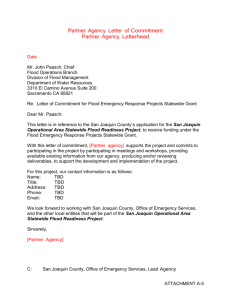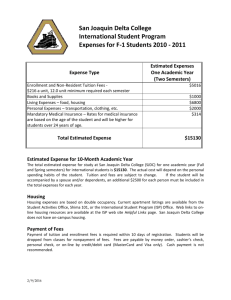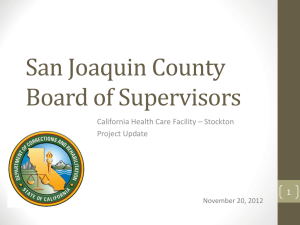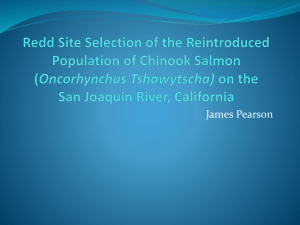2011 San Joaquin County Needs Assessment
advertisement
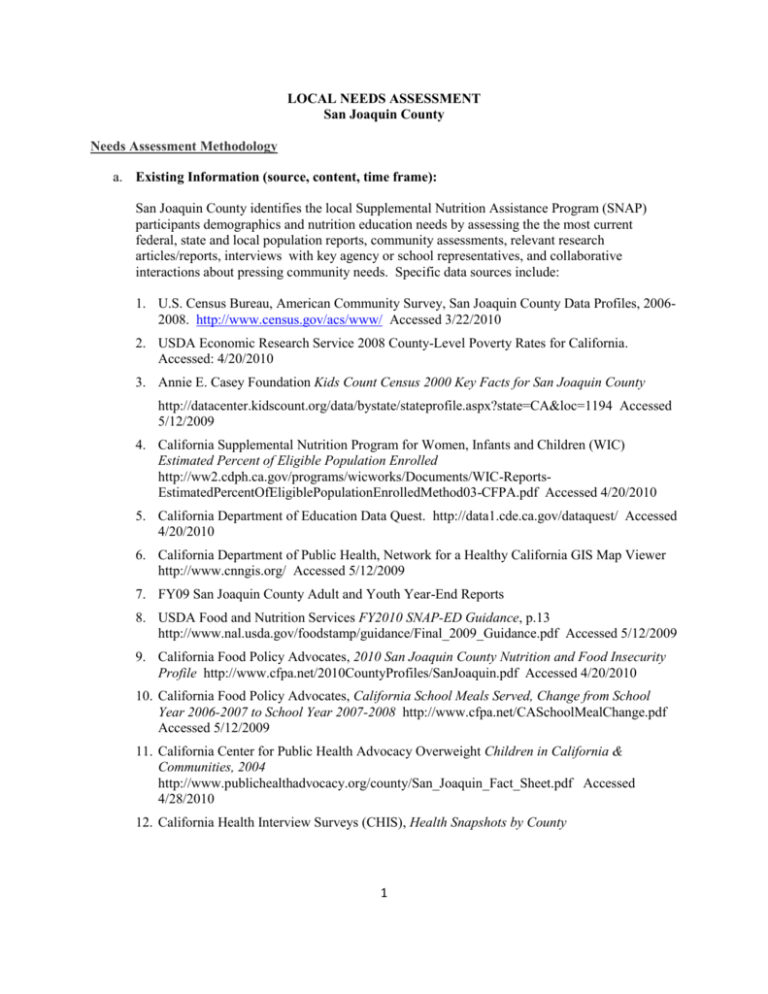
LOCAL NEEDS ASSESSMENT San Joaquin County Needs Assessment Methodology a. Existing Information (source, content, time frame): San Joaquin County identifies the local Supplemental Nutrition Assistance Program (SNAP) participants demographics and nutrition education needs by assessing the the most current federal, state and local population reports, community assessments, relevant research articles/reports, interviews with key agency or school representatives, and collaborative interactions about pressing community needs. Specific data sources include: 1. U.S. Census Bureau, American Community Survey, San Joaquin County Data Profiles, 20062008. http://www.census.gov/acs/www/ Accessed 3/22/2010 2. USDA Economic Research Service 2008 County-Level Poverty Rates for California. Accessed: 4/20/2010 3. Annie E. Casey Foundation Kids Count Census 2000 Key Facts for San Joaquin County http://datacenter.kidscount.org/data/bystate/stateprofile.aspx?state=CA&loc=1194 Accessed 5/12/2009 4. California Supplemental Nutrition Program for Women, Infants and Children (WIC) Estimated Percent of Eligible Population Enrolled http://ww2.cdph.ca.gov/programs/wicworks/Documents/WIC-ReportsEstimatedPercentOfEligiblePopulationEnrolledMethod03-CFPA.pdf Accessed 4/20/2010 5. California Department of Education Data Quest. http://data1.cde.ca.gov/dataquest/ Accessed 4/20/2010 6. California Department of Public Health, Network for a Healthy California GIS Map Viewer http://www.cnngis.org/ Accessed 5/12/2009 7. FY09 San Joaquin County Adult and Youth Year-End Reports 8. USDA Food and Nutrition Services FY2010 SNAP-ED Guidance, p.13 http://www.nal.usda.gov/foodstamp/guidance/Final_2009_Guidance.pdf Accessed 5/12/2009 9. California Food Policy Advocates, 2010 San Joaquin County Nutrition and Food Insecurity Profile http://www.cfpa.net/2010CountyProfiles/SanJoaquin.pdf Accessed 4/20/2010 10. California Food Policy Advocates, California School Meals Served, Change from School Year 2006-2007 to School Year 2007-2008 http://www.cfpa.net/CASchoolMealChange.pdf Accessed 5/12/2009 11. California Center for Public Health Advocacy Overweight Children in California & Communities, 2004 http://www.publichealthadvocacy.org/county/San_Joaquin_Fact_Sheet.pdf Accessed 4/28/2010 12. California Health Interview Surveys (CHIS), Health Snapshots by County 1 13. California Health Interview Surveys (CHIS), Teen Dietary Habits Related to Those of Parents, February 2009 http://www.healthpolicy.ucla.edu/pubs/publication.asp?pubID=321 Accessed 5/12/2009 14. California Health Interview Surveys (CHIS), Low-Income Adolescents Face More Barriers to Healthy Weight, December 2009 http://www.healthpolicy.ucla.edu/pubs/publication.asp?pubID=309 Accessed 5/12/2009 15. Healthier San Joaquin County Community Assessment 2008 http://www.healthiersanjoaquin.org/download.htm Accessed 5/12/2009 16. Children NOW, California County Data Book 2007 http://publications.childrennow.org/assets/pdf/policy/cdb07/cdb07_sanjoaquin.pdf Accessed 5/12/2009 17. Center for Health Improvement, Preschoolers Increasingly Overweight: Preventing Childhood Obesity A Prop 10 Opportunity, Updated Policy Brief, January 2005 http://www.chipolicy.org/pdf/5630.Final%20Childhood%20Obesity%20Brief.pdf Accessed 5/12/2009 18. Center for Disease Control and Prevention, Overweight and Obesity http://www.cdc.gov/nccdphp/dnpa/obesity/childhood/prevalence.htm Accessed 5/12/2009 19. SJC Human Services Agency Monthly Case and Recipient Reports for the Month of March 2010 for Language Distribution, Ethnic Code, Age Distribution, and Zip Code. E-mailed from SJC-HSA on 4/26/2010. 20. Pediatric Nutrition Surveillance System (PedNSS) 2007 http://www.dhcs.ca.gov/services/chdp/Pages/PedNSS2007.aspx Accessed 5/14/2009. 21. Sarah E. Anderson, PhD; Robert C. Whitaker, MD, MPH . Prevalence of Obesity Among US Preschool Children in Different Racial and Ethnic Groups. Arch Pediatr Adolesc Med. 2009;163(4):344-348. 22. Regents of the University of California, PolicyLink, and the California Center for Public Health Advocacy. Designed for Disease: The Link Between Local Food Environments and Obesity and Diabetes . Link: www.publichealthadvocacy.org/designedfordisease.html Accessed 4/28/2010 23. Lopez, G., Crawford, P., Gerstein, D., Ritchie, L., Obesity: Dietary and Developmental Influences. CRC Press March 15,2009. 24. Ritchie, L., Ivey, S., Masch, M., Woodward-Lopez, G., Ikeda, J., and Crawford, P. (June 2001) Pediatric Overweight: A Review of the Literature. UC Berkeley Center for Weight and Health. 25. Woodward-Lopez, G., Ikeda, J., Crawford, P. An excerpt from: Improving Children’s Academic Performance, Health and Quality of Life. 26. Center for Disease Control and and Prevention. FastStats: Obesity and Overweight. Link: http://www.cdc.gov/nchs/fastats/overwt.htm. Accessed: April 28, 2010. 27. San Joaquin County Community Data Co-Op. San Joaquin county Hunger Survey Findings March 2010. 2 Needs Assessment Findings a) Demographic Characteristics of Supplemental Nutrition Assistance Program (SNAP) Eligibles in San Joaquin County. SNAP Participation: According to the 2010 California Food Policy Advocates San Joaquin County Nutrition and Food Security Profile, there are approximately 124,013 SNAP-eligible individuals, adults and children, in San Joaquin County with only 51% (63,244) actually participating in SNAP. (9) The Monthly Case and Recipient reports provided by Human Services Agency (HSA) for March 2010 presented a more recent snapshot of San Joaquin County SNAP caseload and individual recipients (19): Cases by Zip Code for the month of March 2010 totaled 31,549 cases with 72% of the cases in the Stockton area, 9% in Lodi Area, 7% in Manteca, 6% in Tracy, and the additional 6% spread across San Joaquin County’s small rural towns. SNAP participants (n=31,823) report speaking total of 10 languages. Seventy-five percent speak English, 21% Spanish, 4% Southeast Asian (predominately Cambodian, Hmong and Vietnamese). Individual recipients totaled 87,932 with 55% being children and 45% adults; 50% of the children were female and 50% male; 63% of the adults were women and 37% men. Monthly caseloads are up by approximately 16% from 2009. Ethnic Breakdown for the 102,134 was 20% White, 50% Hispanic, 15% Black, 11% Asian (predominantly Cambodian, Laotian and Vietnamese), 2% Filipino, and 2% American Indian/Alaskan Native. Race and Ethnicity: San Joaquin County is one of the roughly 300 counties across the United States with a majority-minority population. In FY09, the San Joaquin County UC-FSNEP adult participants were representative of these diverse ethnic backgrounds with 44.3% Hispanic, 28.7% White, 16.3% Black, 4.2% American Indian/Alaskan Native, 6.4% Asian/ Native Hawaiian or other Pacific Islander. The UC-FSNEP youth participants were also representative of this diversity with 56% Hispanic, 16% White, 14% Asian or Pacific Islander, 13% Black, and 1% American Indian/Alaskan Native. (7) Age: San Joaquin County’s median age for all incomes is 31.7 years of age with and estimated 71% of the population 18 years and over, 21% 5 to 19 years, and 8% under 5 years (1). Gender: San Joaquin County has an evenly split population (all incomes) between male and female, 50% male, 50% female (1). The San Joaquin County UC-FSNEP program has the same even 50/50 gender split with the youth program but the adult participants tend to be predominately female (FY09 adult participants were 78% female and 22% male). (7) Households and Families: Three year estimates from ACS Surveys for 2006-2008 indicated there were 207,583 households in San Joaquin County with 75% (154,864) considered family households. (1) 3 Industry: Agriculture is the number one industry in San Joaquin County. Language: Twenty-three percent of the people living in San Joaquin County in 2006-2008 were foreign born. Among people five years and older living in San Joaquin County in 2006-2008, 38 percent spoke a language other than English at home. Of those 38% speaking a language other than English at home, 25% spoke Spanish and 9% Asian/Pacific Islander languages. All but 2% of these people reported they spoke English “less than well”. (1) California Department of Education 2008/2009 data indicates 23% of our youth are English language learners (5). UCFSNEP educators estimate that the primary languages of their participants, other than English, are Spanish (38%), Hmong (5%), Khmer (Cambodian) (5%) and Vietnamese (2%). Geographic location: The majority of San Joaquin County SNAP recipients and those eligible live in county census tracts where more than 50% of the populations have incomes below 185% of the Federal Poverty Level (FPL). For San Joaquin County, these census tracts are located primarily in the Stockton area but other population centers such as Lodi, Tracy, Ripon, Lathrop and Escalon have 1-2 low-income census tracts each. The San Joaquin County UC-FSNEP program has agreements with agencies and organizations serving low-income, ethnically diverse populations (all races) in 24 qualifying census tracts. The majority are in the Stockton area. Several sites are located in Escalon, Lathrop, Ripon and Tracy in qualifying census tracts for the Hispanic population. (6) Free/Reduce Price Lunch Enrollment: The San Joaquin County UC-FSNEP Youth Program has MOU’s with all school districts and several schools throughout San Joaquin County. The percentage of children enrolled in the free and reduced price lunch program throughout San Joaquin County was 56.7% (74,936) in 2008/2009 compared to 53.3% in 2007/2008 (70,941children) and 50.4% in 2006/2007 (67,556 children). The two largest school districts free and reduced price lunch enrollment in 2008/2009 were Stockton Unified School District 78.5% (29,840) and Lodi Unified School District with 59.7% (18,397). (5) As San Joaquin County families continue to struggle with job losses and/or financial hardships, families who enroll their children for free and reduced price lunches is expected to continue to increase in 2009/2010. Poverty in San Joaquin County: Approximately 15.3% of 652,139 individual county residents are living on incomes below poverty level. The percentage of families with incomes below poverty level is 11.8%. Approximately 28% of the female-headed households have incomes below poverty level compared to 7% of the married couple families. This figure increases to 34% for female-headed households with children under 18 years compared to 10% of the married couple families. (1) b) Nutrition-Related Behavioral And Lifestyle Characteristics Of Food Stamp Program Eligibles In San Joaquin County Food Insecurity in San Joaquin County: California Food Policy Advocates 2010 San Joaquin County Nutrition and Food Insecurity Profile indicates 30% (41,000 individuals) of low-income adults in San Joaquin County report residing in food insecure households. With 58 counties being ranked in California and “1” being the best ranking, San Joaquin County ranked as follows for utilization of food and nutrition assistance programs: Food Stamp Program-20, National School Lunch Program-26, School Breakfast Program-50 and Summer Nutrition Programs-1. 4 Each of these programs can be commended for the role they play in ensuring low-income families and their children don’t have to worry about having enough to eat each day. At the same time the role these programs play in feeding hungry and food insecure children and their families is still dismal if you consider if you consider that 61,000 income eligible individuals do not participate in the Food Stamp Program, 21,315 eligible students do not participate in the National School Lunch Program, 34,300 eligible students do not participate in the School Breakfast Program, and 11,170 eligible students do not participate in the Summer Nutrition Program. (9) The San Joaquin County Data Co-Op collaborated with the Hunger Taskforce of San Joaquin County and the Emergency Food Bank of Stockton/San Joaquin to conduct a county hunger survey. The survey was conducted at various emergency food locations throughout San Joaquin County. Of the 926 respondents, 39% reported being hungry in the last 12 months and not eating because there was not enough money for food; and 76% reported their children skipped meals because there was not enough money for food. At the same time, only 38% were food stamp recipients. Of concern was the 49% who reported someone in their home had diabetes and 37% had heart disease while at the same time 55% were putting off health care due to financial problems. (27) Although this was a convenience sample of county residents seeking emergency food assistance, their self-reported family health status supports the importance of finding ways to deliver health promotion messages while at the same time improving the nutritional quality of the foods in their emergency food bags and providing education on preparing healthy, tasty low-cost meals. Overweight/Obesity: Addressing the factors related to the prevalence of overweight and obesity are a priority issue of San Joaquin County UC-FSNEP. Nationally, the Center for Disease Control and Prevention FASTSTATS (26) for the noninstitutionalized populations in 2005-2006 indicate: 67% of adults age 20 years and over are overweight or obese. 34% of adults age 20 years and over are obese. 18% of adolescents age 12-19 years are overweight. 15% of children age 6-11 years are overweight. 11% of children age 2-5 years who are overweight Other sources of data indicate the following: Preschoolers: A study published in the Archives of Pediatrics & Adolescent Medicine analyzed height and weight data on 8,550 preschoolers born in 2001. Children were measured in their homes and were part of a study conducted by the government's National Center on Educational Statistics. The study reported obesity results for these children, not overweight, which makes the results alarming. Almost 13% of Asian children were obese, along with 16% of whites, almost 21% of blacks, 22% of Hispanics, and 31% of American Indians (21). Schoolage Children: The California Center for Public Health Advocacy analysis of the 2004 California Physical Fitness Test of 5th, 7th and 9th graders shows 29.6% of children in San Joaquin County are overweight. These overweight rates in cities in San Joaquin County ranged from 25.8% in Tracy to 31.8% in Stockton. (11) The California County Data Book for 2007 reports 34% of San Joaquin County children (all incomes) are overweight. Related behavioral characteristics include 70% of San Joaquin County children never exercise and 35% ate fast food in the prior day. (16) Adolescents/Teens: In California nearly 480,000 adolescents (14%) are obese, and there are large income disparities. Obesity prevalence is more than twice as high among low-income teens compared with those from more-affluent households (21% vs. 8%). Lower-income 5 adolescents experience more obstacles to healthy weight than their more affluent peers— including living in less healthy food environments and having fewer opportunities for physical activity. Many adolescents drink soda and eat fast food every day but do not eat adequate amounts of fruits and vegetables. These eating patterns are linked with the eating patterns of their parents. (13, 14) Adults: The California Food Policy Advocates 2010 San Joaquin County Nutrition Profile reported 65% of adults in San Joaquin County were overweight or obese. (9) Recommendations by Researchers to Combat Overweight and Obesity: Dietary: Calories count, reduce intake of dietary fat, replace refined carbohydrates with high fiber foods, increase the intake of fruits and vegetables, ensure adequate intake of calcium and low-fat dairy, reduce Intake of Sweetened Beverages, reduce consumption of restaurant-prepared foods or choose more wisely, eat breakfast on a regular basis, and breastfeed (23) Physical: Increase physical activity and reduce TV time. (23) Social Marketing Techniques: Multiple communication and delivery channels, a strong family component to facilitate change outside the school environment, and changes in the social structure, environment or system to facilitate the promoted behavioral changes (24) Food Insecurity and Obesity: Food insecure children are at high risk for obesity primarily because diets of poor and food insecure families tend to be especially high in fat and low in fruits, vegetables and dairy products. As these families attempt to stretch the food dollar and stave off hunger, they tend to purchase low cost, high calorie foods of poor nutritional value. (25) Retail Food Environment Index (RFEI): According to a 2007 study by the California Center for Public Health Advocacy, California has more than four times as many fast-food restaurants and convenience stores as grocery stores and produce vendors—suggesting that Californians have greater access to foods with lower nutritional values than to healthier foods. Designed for Disease: The Link Between Local Food Environments and Obesity and Diabetes (22) examined the relationships between retail food environments, obesity and diabetes, and community income. The study demonstrated that people who live near an abundance of fast-food restaurants and convenience stores compared to grocery stores and fresh produce vendors, have a significantly higher prevalence of obesity and diabetes. The highest rates of obesity and diabetes are among people who live in lower-income communities and have worse food environments. Researchers calculated an RFEI for each California county by dividing the total number of fast-food restaurants and convenience stores by the total number of grocery stores (including supermarkets) and produce vendors (including produce stores and farmers’ markets) within a given radius around their home address (0.5 mile in urban areas, 1 mile in smaller cities and suburban areas, and 5 miles in rural areas).35, 36 Thus the RFEI is an indicator of the density of food outlets that are less likely to stock fresh fruits and vegetables and other healthy foods. A higher RFEI indicates that a person lives near a larger number of fast-food restaurants and convenience stores relative to the number of grocery stores and produce vendors. For example, an individual with an RFEI of 2.0 has twice as many fast-food restaurants and convenience stores nearby compared to grocery stores and produce vendors. San Joaquin County’s RFEI is 4.53. Access to Fresh Fruits and Vegetables: Anecdotally, program participants express the inability to afford fresh fruits and vegetables for their families. Resident and health leaders are increasingly expressing an interest in the development of community and school gardens. Some areas of county do not have access to a variety of fresh fruits and vegetables contributing to low 6 consumption by residents. San Joaquin County has a total of 8 Certified Farmer’s Markets but only 3 accept EBT coupons. c) Other Nutrition-Related Programs Serving Low-Income Persons In San Joaquin County San Joaquin County provides a wide-array of nutrition-related programs and services that bring nutrition and/or nutrition education to low-income individuals and families--WIC, SNAP (formerly the Food Stamp Program), USDA Child and Adult Care Food Program, Head Start, Healthy Start, Aging and Community Services Brown Bag Program, Commodities Program and Meals-on-Wheels Program, and a variety of soup kitchens and food pantries. Kaiser Permanente, Health Plan of San Joaquin, Anthem Blue Cross, St. Joseph’s Medical Center/Catholic Healthcare West, Sutter Gould Medical Foundation, and various local non-profits work closely with the community to support nutrition and healthy lifestyle trainings, education, and health-related events. Central California Regional Obesity Prevention Program is currently being implemented in Southeast Stockton by Public Health, Community Partnership for Families and the Healthy San Joaquin Collaborative. The Agricultural Commissioner’s Select San Joaquin team and the Farm Bureau partner with community leaders to promote local agriculture and its value to our economic and personal health. San Joaquin County is home to the following SNAP-Ed funded programs: UC-FSNEP, San Joaquin County Public Health Services Network for a Healthy California, Emergency Food Bank’s Mobile Farmer’s Market (CA Association of Food Banks) and Nutrition on the Move Series (UC-FSNEP/EFB Partnership), Community Medical Centers (Central Valley Health Network), and Gold Country Regional Nutrition Network Campaigns i.e. Children’s PowerPlay Campaign. Additionally, San Joaquin County EFNEP is administered by UCCE San Joaquin County. d) Areas Of San Joaquin County Where Food Stamp Program Eligibles Are Underserved Or Have Not Had Access To FSNE Previously . Underserved SNAP-Ed eligible populations or areas in San Joaquin County include: Family-centered education: Although SNAP-Ed funded programs have collaborated in an effort to reach more parents without duplicating efforts, there is still room for growth in parent nutrition education programs/workshops. Teens/adolescents: SNAP-Ed eligible students attending middle schools, community schools and high schools in the county. Elementary School Children: K-8 students in FSNEP-eligible elementary schools not served by either Network, UC-FSNEP or other nutrition education programs. Afterschool children: Although many of our after schools in the county have implemented the Children’s PowerPlay Campaign and/or UC-FSNEP Reading Across the MyPyramid, there is still room for growth. Preschool children: Although many of our preschools in the county have implemented Happy Healthy Me and/or Go, Grow, Glow, there is still room for growth. Seniors: The Senior SNAP-eligible population does not have a comprehensive nutrition education program at this time. e) Implications of Your Needs Assessment and How These Findings Were Applied To This Current Year’s FSNE Plan. 7 Family-Centered Nutrition Education Increase number of parent-centered SNAP-Ed educational opportunities, with special attention to mothers and other adult family members. Training First-5 funded subcontractors to deliver age-appropriate, interactive nutrition educaiton to parents and their children (under 5 years of age) in their homes as part of the First 5 Health Access Initiative’s Child Wellness Program. Youth Nutriton Educaiton Continue the collaborative agreement with the Health Education Council, Public Health LIA and San Joaquin County UC-FSNEP to implement the Children’s PowerPlay Campaign in all county after schools. Increase the number of HHM and GGG kits and develop RAMP kits for teachers to reduce teacher prep time and encourage nutrition education delivery in classrooms. Overweight and Obesity Focus lessons on factors contributing to overweight and obesity in all populations, especially those emphasized in the FY10 guidance. Employ bilingual English/Spanish Nutrition Educators to deliver SNAP-Ed workshops to the Spanish-language parents, especially mothers. Continue to provide leadership to the Healthy San Joaquin Collaborative in their efforts to improve the nutrition and physical activity environment throughout the county i.e. access to healthy, affordable food; access to safe places to play; and integration of SNAP-Ed resources into community and school environments. Poverty, Obesity and Food Insecurity Partner with Emergency Food Bank to extend SNAP-Ed through a more comprehensive, indepth series of lessons focused on food resource management, stretching their food dollar, and increasing fruit and vegetable consumption – Nutrition on the Move Program. Training agency staff and/or volunteers from Human Services Agency, Community Partnership for Families, and others to deliver Making Every Dollar Count to adult family members facing financial challenges to putting healthy foods on their tables. Provide leadership to the Hunger Taskforce of San Joaquin County in their efforts to improve the health and wellness outcomes of food insecure individuals and families. Development of Partnerships Continue to work on developing a partnership with the UCCE San Joaquin County Master Gardener Program to provide garden-enhanced nutrition education for interested schools and community sites. Continue to collaborate with Agricultural, Supermarket and Health Leaders i.e. Agricultural Commission, Farm Bureau, Public Health, Food-4-Less/Centro Mart, Public Health Services, and many others to connect the key messages from the MyPyramid to the number one industry in San Joaquin County—Agriculture. Continue to work with Public Health Services, Community Partnership for Families and Healthy San Joaquin Collaborative members to support SNAP-Ed related projects in Southeast Stockton, including CCROPP and/or a faith-based health promotion program. Provide leadership to address the overlap and gaps in SNAP-Ed delivery through monthly meetings with other San Joaquin County LIA’s and other federally funded nutrition-related 8 programs with the goal of delivering SNAP-Ed key messages to greater numbers of SNAP-Ed eligible individuals and families. 9

